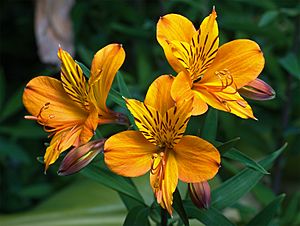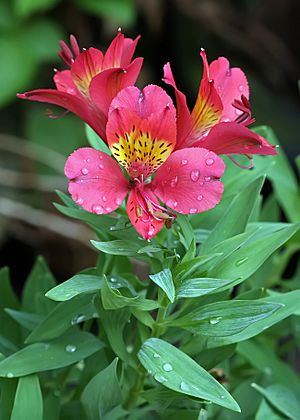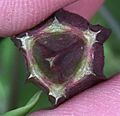Alstroemeria facts for kids
Quick facts for kids Alstroemeria |
|
|---|---|
 |
|
| Peruvian lily (Alstroemeria aurea) | |
| Scientific classification |
|
| Kingdom: | Plantae |
| Clade: | Tracheophytes |
| Clade: | Angiosperms |
| Clade: | Monocots |
| Order: | Liliales |
| Family: | Alstroemeriaceae |
| Genus: | Alstroemeria L. |
| Type species | |
| Alstroemeria pelegrina |
|
| Synonyms | |
|
|
The Alstroemeria, often called the Peruvian lily or lily of the Incas, is a group of beautiful flowering plants. They belong to the Alstroemeriaceae family. These plants originally come from South America. However, some have started growing naturally in other places like the United States, Mexico, Australia, New Zealand, the Madeira Islands, and the Canary Islands.
Most Alstroemeria species are found in two main areas: central Chile or eastern Brazil. The plants from Chile grow during winter, while those from Brazil grow in summer. Most of them are perennials, meaning they live for many years. One small exception is A. graminea, which is an annual plant (lives for only one year) from the Atacama Desert in Chile.
Contents
What Alstroemeria Plants Look Like
These plants grow from a group of tubers, which are like thick underground stems. They send up different kinds of stems. Some stems are fertile and can grow flowers, reaching up to 1.5 meters (about 5 feet) tall in some species.
The leaves are arranged one after another along the stem. They are also "resupinate," which means they twist on their stalks so that the underside of the leaf faces upwards. The leaves come in different shapes and have smooth edges.
Alstroemeria Flowers
The flowers can grow alone or in groups called umbels, which look like an umbrella shape. Each flower has six petals, and each petal can be up to 5 centimeters (about 2 inches) long. They come in many bright colors like red, orange, purple, green, and white. Often, they have darker spots, stripes, or streaks on them.
Inside the flower, there are six curving stamens, which produce pollen. The part that receives pollen, called the stigma, has three parts. After the flower blooms, it produces a fruit that is a capsule with three sections. Alstroemeria are known as "inferior monocots," meaning their petals are located above the part of the flower that becomes the fruit.
The History of Alstroemeria
The Alstroemeria plant group was first described by Johan Peter Falk and his teacher Carl Linnaeus. Linnaeus is a famous Swedish scientist who created the system we use today to name living things. They wrote about the plant in a paper called Planta Alströmeria in 1762.
How Alstroemeria Got Its Name
The genus Alstroemeria was named after a Swedish baron named Clas Alströmer (1736–1794). He was a good friend of Carl Linnaeus.
Growing and Using Alstroemeria
People have created many different types of Alstroemeria plants by mixing them. These are called hybrids. There are at least 190 different cultivars (types grown by people) with many colors and patterns. You can find them in white, yellow, orange, pink, red, purple, and lavender.
The most popular and beautiful hybrids we see today come from mixing species from Chile (which grow in winter) with species from Brazil (which grow in summer). This clever trick helped solve a problem for florists: it made the plants flower almost all year round instead of just seasonally. This breeding work started in the United States in the 1980s, but now most of the new types are developed by companies in the Netherlands.
These flowers look like small lilies and are very popular for bouquets and flower arrangements. They are often used in the commercial cut flower business because they can stay fresh in water for up to 14 days without wilting.
If you want to grow Alstroemeria in your garden, most types will bloom in late spring and early summer. Their roots can handle temperatures down to about -5°C (23°F). These plants need at least six hours of morning sunlight, regular water, and soil that drains well.
Award-Winning Alstroemeria Types
Some Alstroemeria types have won the Royal Horticultural Society's Award of Garden Merit. This award means they are excellent plants for gardens. Most of these can handle average winter temperatures between -10°C and -5°C. One type, 'Friendship', is even hardier and can survive colder winters, down to -15°C.
- 'Apollo' (white/yellow flowers, 100cm tall)
- 'Cahors' (pink/yellow, 90cm tall)
- 'Coronet' (salmon/yellow flowers, 140cm tall)
- 'Friendship' (yellow flushed pink, 100cm tall)
- 'Orange Glory' (150cm tall)
- 'Oriana' (salmon/yellow, 50cm tall)
- 'Phoenix' (red/yellow, 100cm tall)
- 'Red Elf' (100cm tall)
- 'Sirius' (pink/yellow, 100cm tall)
- 'Sonata' (red/yellow, 100cm tall)
- 'Spitfire' (orange/yellow, 90cm tall)
- 'Tessa' (red flowers, 120cm tall)
- 'Yellow Friendship' (140cm tall)
Alstroemeria in Nature
Sometimes, Alstroemeria plants that were grown in gardens escape and start growing wild. When this happens, they can become weeds. For example, Alstroemeria pulchella and A. aurea are now considered weeds in Australia.
Images for kids
See also
 In Spanish: Alstroemeria para niños
In Spanish: Alstroemeria para niños


























